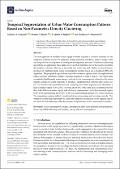Показать сокращенную информацию
Temporal Segmentation of Urban Water Consumption Patterns Based on Non-Parametric Density Clustering
| dc.contributor.author | Kapanski, A. A. | |
| dc.contributor.author | Klyuev, R. V. | |
| dc.contributor.author | Brigida, V. S. | |
| dc.contributor.author | Hruntovich, N. V. | |
| dc.coverage.spatial | Basel | ru_RU |
| dc.date.accessioned | 2025-10-07T10:45:47Z | |
| dc.date.available | 2025-10-07T10:45:47Z | |
| dc.date.issued | 2025 | |
| dc.identifier.citation | Temporal Segmentation of Urban Water Consumption Patterns Based on Non-Parametric Density Clustering / A. A. Kapanski, R. V. Klyuev, V. S. Brigida, N. V. Hruntovich // Technologies. – 2025. – № 13. – Р. 1–17. | ru_RU |
| dc.identifier.uri | https://elib.gstu.by/handle/220612/42814 | |
| dc.description.abstract | The management of modern water supply systems requires a detailed analysis of consumption patterns in order to optimize pump operation schedules, reduce energy costs, and support the development of intelligent management systems. Traditional clustering algorithms are applied for these tasks; however, their limitation lies in the need to predefine the number of clusters. The aim of this study was to develop and validate a non-parametric method for clustering daily water consumption profiles based on a modified DBSCAN algorithm. The proposed approach includes the automatic optimization of neighborhood radius and the minimum number of points required to form a cluster. The input data consisted of half-hourly water supply and electricity consumption values for the water supply system of Gomel (Republic of Belarus), supplemented with the time-of-day factor. As a result of the multidimensional clustering, two stable regimes were identified: a high-demand regime (6:30–22:30), covering about 46% of the data and accounting for more than half of the total water supply and electricity consumption, and a low-demand regime (0:30–6:00), representing about 21% of the data and forming around 15% of the resources. The remaining regimes reflect transitional states in morning and evening periods. The obtained results make it possible to define the temporal boundaries of the regimes and to use them for data labeling in the development of predictive water consumption models. | ru_RU |
| dc.language.iso | en | ru_RU |
| dc.publisher | MDPI | ru_RU |
| dc.subject | Water consumption | ru_RU |
| dc.subject | Energy consumption | ru_RU |
| dc.subject | Intra-daily patterns | ru_RU |
| dc.subject | Non-parametric clustering | ru_RU |
| dc.subject | DBSCAN | ru_RU |
| dc.subject | Temporal labeling | ru_RU |
| dc.subject | Energy-efficient management | ru_RU |
| dc.title | Temporal Segmentation of Urban Water Consumption Patterns Based on Non-Parametric Density Clustering | ru_RU |
| dc.type | Article | ru_RU |
| local.identifier.doi | 10.3390/technologies13100449 |
